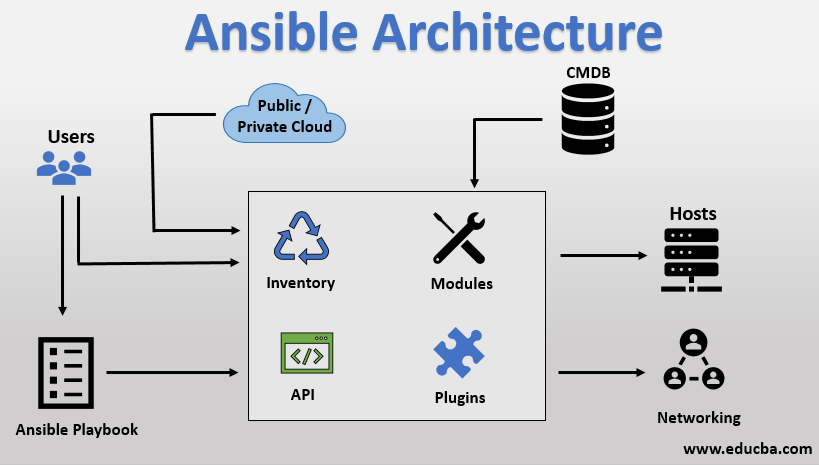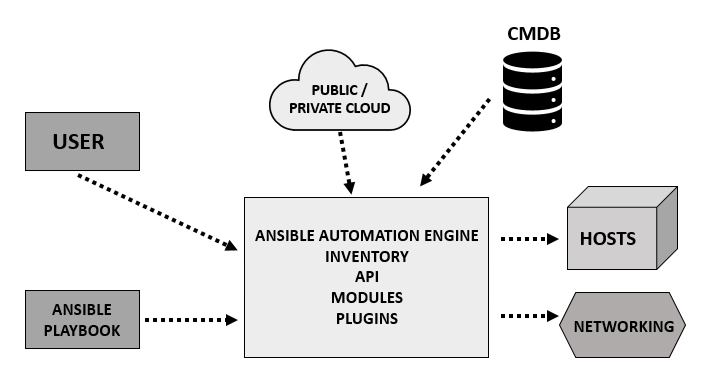Updated March 16, 2023

Introduction to Ansible Architecture
Any organization’s common task is the frequent deployment of applications which includes automation, cloud provisioning, and many other IT tools. Ansible is an open-source tool that is very easy to understand that does not use any other third-party tool or any kind of complex security mechanism. It makes use of playbook to perform the entire end to end automation of components. Basically, the playbook is written in a simple human-readable language which includes YAML (Yet another markup language). All configuration files are mostly written in YAML. So, the overall advantage of using it Is that any new IT people can also read it and understand the machine level automation or code level thing and provides the feature of debugging as well. in this article, we will look in detail about the architecture of ansible.
The beauty of Ansible is that it is not only composed for single-tier deployment. It is done for kind of multi-tier systems and infrastructures. It is often coined with a term as agentless which means it works by connecting nodes through default login(ssh).
Whenever it comes to software or hardware of machine it clearly comes into picture configuration management of the product, therefore, it is very much needed to keep a track of the entire health check and recording of updated details.
For example, a new release of any software comes then how the IT team of an organization can keep a check on it a possible solution is to install all updated software like WebLogic server on all machines of your enterprise. It is not at all possible to install all software manually on all servers.
A very simple way or an alternative is to install Ansible playbook which is written in very user-friendly syntax and language. Run the playbook from your control machine and all nodes will become updated with the latest version changes.
Architecture of Ansible
Ansible architecture is easy to understand:
From the above diagram visibility comes into the picture:
- Users: Users who create Ansible playbook has a direct connection with ansible automation Engine.
- Ansible playbook: It also interacts with the ansible automation engine and configuration Management Database
- Public or Private cloud: They help in interacting with all the modules and API with this but also with the entire cloud which proves that it has security measures as well.
- Inventory: Inventory which is a part of the automation engine helps in provisioning and internal provisioning using automation.
- API: It helps in creating necessary API for the interaction of end to end modules.
- Modules: The modules are directly run using playbooks the modules can control all services, packages, AWS cloud formation, etc.
- Plugins: All necessary cache, logging purpose, ansibles functioning all help in creating augmented ansible’s core.
- Networking: It helps to automate different networks that make use of all agentless frames and generate useful configurations.
- Hosts: Hosts here refers to the machines like Linux or Unix machines which are getting automated using Ansible.
- CMDB (Configuration Management Database): It is a kind of repository that consists of an entire network of computers of operational or IT infrastructure.
Advantages of Ansible Infrastructure
Following are the advantages explained.
- Easy and Understandable: Ansible is very simple and easy to understand and has a very simple syntax that can be used by human-readable data serialization language. It is very good for beginners to understand especially for those who design infrastructure.
- Powerful and Versatile: it is a very powerful and versatile tool that helps in real orchestration and manages the entire application or configuration management environment.
- Efficient: It is very efficient in the sense it can be customized according to your need like modules can be called with the help of a playbook for where the applications are deployed.
- Agentless: Completely independent tool without the use of third-party vendors or agent’s software and agentless.
- Provisioning: Applications in need of orchestration get a total aid from ansible as it helps in provisioning of resources according to the need of the project requirement.
- Application Deployment: Easy for teams to manage the entire lifecycle from development to deployment.
- Orchestration: ONAP orchestration and all cloud-native platforms very well make use of ansible tool in its use.
- Secured: Security is the key to maintain the ansible infrastructure as all applications require it to get applications free from security breaches.
Conclusion
We can Conclude that DevOps is integrated as both dev and Ops team work together. Ansible plays a very crucial role as it allows both to come together and perform the automation activity followed by monitoring. It is a very promising tool, in fact, NASA also made use of the Ansible tool as it has the capability to manage and orchestrate the entire infrastructure to provide better upliftments to the development and operational team. In the mere future, we can predict that Ansible will help in creating a more versatile and flexible environment by incorporating the upgraded versions and tools as per the requirements of the project lifecycle or pipeline.
Recommended Articles
This is a guide to Ansible Architecture. Here we discuss the introduction and ansible architecture which includes users, ansible playbook, API, Modules etc along with its advantages. You may also look at the following articles to learn more –


